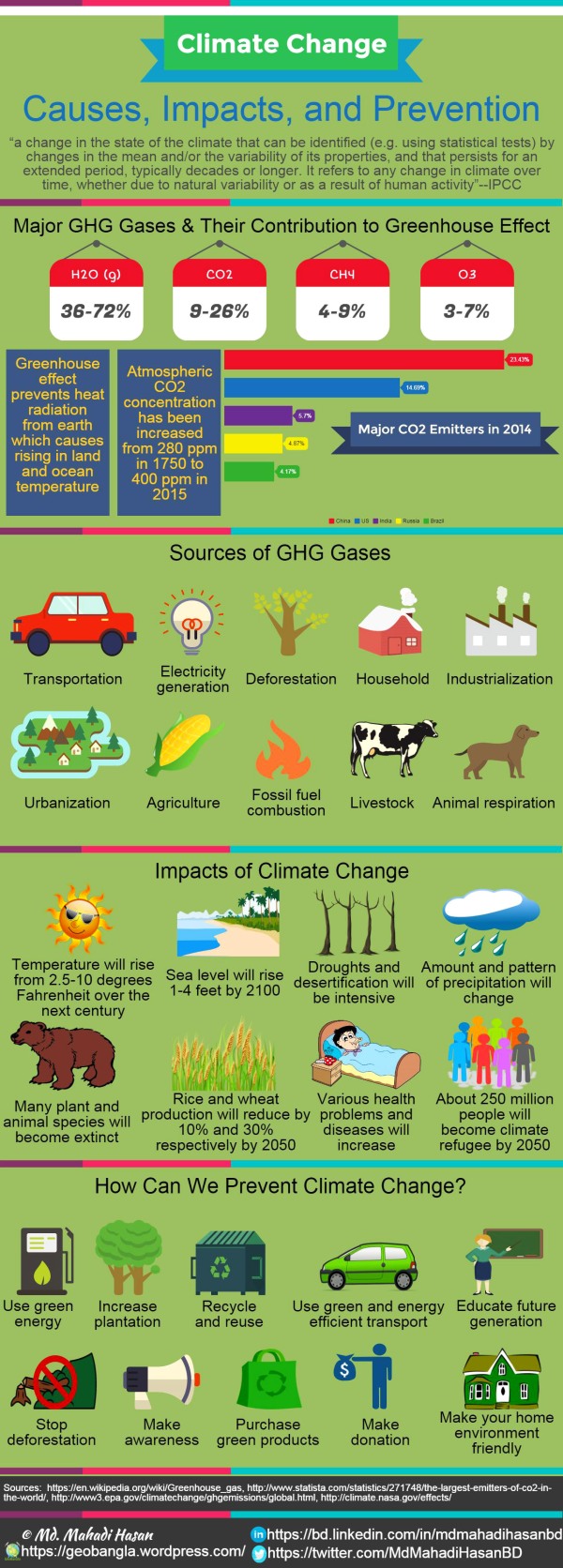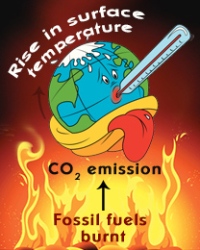Reasons to Worry About Climate Change
As per the recent UN report, climate change sounded an alarming note: The
problem is real, it is growing and the worst is yet to come. We need to think of
the dire consequences of not reducing greenhouse gases as the Top 10
Reasons to Worry About Climate Change.
For more information pl refer
https://www.usnews.com/news/slideshows/top-10-reasons-to-worry-about-climate-change?onepage
Impacts of Climate Change Will Make You More Worried
Climate change is one of the greatest environmental, social, and
economic threats that the world faces today. With 160 million people, Bangladesh
is one of the largest deltas in the world which is highly vulnerable to
natural disasters because of its geographical location, flat and
low-lying landscape, population density, poverty, illiteracy, lack of
institutional setup etc. Moreover, the adverse effects of climate change
– especially high temperature, sea-level rise, cyclones and storm
surges, salinity intrusion, heavy monsoon downpours etc. has aggravated
the overall economic development scenario of the country to a great
extent.

You Need to Know What Climate Change Actually Means
Intergovernmental Panel on Climate Change (
IPCC)
defines climate change as “a change in the state of the climate that
can be identified (e.g. using statistical tests) by changes in the mean
and/or the variability of its properties, and that persists for an
extended period, typically decades or longer. It refers to any change in
climate over time, whether due to natural variability or as a result of
human activity”.
Climate change generally refers to global changes in temperature,
wind, precipitation, the length of seasons as well as the strength and
frequency of extreme weather events like droughts and floods.
Warming of the climate system is unequivocal, as is now evident from
observations of increases in global average air and ocean temperatures,
widespread melting of snow and ice and rising global average sea level.
The period from 1983 to 2012 was likely the warmest 30-year period of
the last 1400 years in the Northern Hemisphere. The globally averaged
combined land and ocean surface temperature increased about 0.85°C over
the period from 1880 to 2012. Increases in sea level are consistent with
warming. Over the period 1901 to 2010, global mean sea level rose by
0.19m per year (IPCC: Climate Change 2014: Synthesis Report).
What Are The Causes of Climate Change?

The world climate is changing mostly because of
greenhouse effect.
Water vapor (H2O), carbon dioxide (CO2), CFC, methane (CH4), nitrous
oxide (N2O) etc. are common greenhouse gases. China, USA, India, Russia,
and Brazil are the major greenhouse gas emitters.
The heat of the sun usually goes back to the outer space by
radiation. But the greenhouse effect prevents the radiation of the heat.
For this reason the average temperature of the world is increasing. The
main causes of greenhouse gas emissions are:
Anthropogenic Greenhouse Gas (GHG) Emissions:
Anthropogenic GHG emissions have increased since the pre-industrial
era, driven largely by economic and population growth, and are now
higher than ever. Global GHG emissions have been increased about 70%
between 1970 and 2012. Between 1750 and 2011, cumulative anthropogenic
CO2 emissions to the atmosphere were 2040 ± 310 GtCO2.
Fossil Fuel Combustion:
Emissions of CO2 from fossil fuel combustion and industrial processes
contributed about 78% of the total GHG emissions increase from 1970 to
2010.
Deforestation and Urbanization:
Everyday over 5500 acres of rain forest are destroyed resulting about 0.4% rise of CO2 level per year.
Impacts of Climate Change in Bangladesh
Bangladesh experiences different types of Natural Disasters almost
every year because of the Global Warming as well as climate change. More
than 100 types of changes have been observed in the environment of Asia
because of climate change. Bangladesh is under great threat of climate
change because of its geographic location. The probable threats to
Bangladesh are:
Disappearing Seasons of Bangladesh:
The seasons of Bangladesh are disappearing due to climate change.
Summer and rainy season are prolonging while winter season is shrinking.
Autumn and Dewy season are vanishing.
Flooding in Coastal Areas:
Almost 80% of the total area of the country is prone to flooding.
According to IPCC, the sea level of the Bay of Bengal will be increased
about one meter by this century. As a result a huge amount of
coastal area of Bangladesh will be submerged under water.
Natural Disasters:
Flood, cyclone, drought, river bank erosion etc. will be increased and intensified due to the change of climate.
Crop Production and Food Security:
The average temperature of Bangladesh will be increased up to 2
degree Celsius by the year of 2050 due to global warming. It will reduce
the production of rice up to 10% and wheat up to 30% due to the
shortage of water for irrigation.
Fisheries and Forests:
The fisheries sector has also experienced an adverse effect because
of the impacts of climate change. There are around 260 species of fish
in the country and almost all the varieties are sensitive to specific
salt and freshwater conditions.
About 75% area of mangrove forest, the Sundarban, will be submerged
if the sea level rises up to 45cm. If the seal level rises over 1 meter,
the whole mangrove forest will be submerged under sea water.
Water Resources:
The effects of climate change on the surface and groundwater
resources will be very severe and alarming. The rivers are becoming dry
and salinity intrusion is taking place. As a result, there will be huge
crisis for fresh water. Irrigation, fishery, industrial production,
navigation will also be affected to a great extent.
Public Health:
Various health problems and diseases will be increased due to climate
change. Frequent floods and cyclonic storm surges are contaminating
water resources increasing water borne diseases such as cholera,
diarrhea etc. Some other diseases like hepatitis-B, cerebral
contamination, meningitis, polio will be increased. Rise of temperature
will favor for pests and pathogens that will increase dengue, malaria,
etc.
Climate Refugee:
Only 1 meter sea level rise in Bangladesh will lead to 15% loss of
its total land area and around 30 million people living in the coastal
areas of Bangladesh would become climate refugees.
Conclusion
Global climate change will affect the people and the environment in
many ways. Some of these impacts like strong hurricanes and severe heat
waves can be life threatening. It is difficult to sustain fight against
the nature. But the nature usually does not behave rudely with the human
beings. We, the human beings are mostly liable for making the nature
unruly. We have destroyed our environment intentionally or
unintentionally. The more we learn about how climate change will affect
people and environment, the more we can say why people need to take
action to reduce the greenhouse gas emissions. Being one of the most
affected and vulnerable countries of the world due to climate change,
Bangladesh is certainly well positioned to raise its voice and bargain
for getting for a fair share in a global climate deal.
For more information please refer
https://geobangla.wordpress.com/2015/10/19/impacts-of-climate-change-in-bangladesh/



